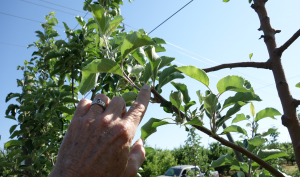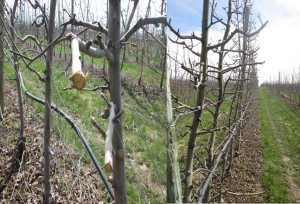Written by Karen Lewis, WSU Extension. May, 2018.

Mechanical hedging is not new to tree fruit production. Researchers and growers researched and evaluated the use of hedgers back in the 60’s and 70’s with mostly negative results in apples. On full size and even semi dwarf trees the results from hedging was as expected. At the site of the cut you would get a blow out and witches broom response. Trees on dwarfing, precocious and productive rootstocks are calmer and therefore the response is just what we would expect – a short, weak shoot (Figure 1).
Not including what’s in your boneyards, my sources indicate there are 15 – 20 hedgers in Washington State this spring. Of these, a dozen or so have been purchased in the last 2 years. When I ask people what they want to accomplish with hedging I generally get one or a combination of the following: 1) develop or maintain a narrow canopy; 2) define the height and width of the canopy; 3) set block up for mechanization; 4) increase light penetration to improve fruit color, fruit quality; 5) get rid of blank wood near the trunk and; 6) reduce pruning costs.
I have mostly worked in blocks that were not trained to a fruiting wall or narrow canopy at planting. Instead I have worked in spindle and axe trees that the grower was interested in transitioning to a narrow canopy and filling up some of the space between tree with fruiting sites. For new blocks, you should decide if hedgers are going to be in your toolbox and hedging part of your strategy BEFORE you design and establish your block. If your desired canopy architecture is made up of short stiff limbs with 2-5 fruiting sites, hedgers can be a great tool to meet that goal (Figure 2). You can keep limb length equal from top to bottom or you can angle your tool to allow for a slight conical shape or longer limbs in the bottom. This architecture, or slight variations of this is ideal for improved machine interface and employee interface, sunlight interception and distribution, and improved spray deposition.

Equipment: Commercially available hedgers include single and double row styles, sickle bar and circular blade systems, some are designed to hedge in the horizontal position (tree topping) and vertical while others only operate in the vertical position. All have some degree of tilt capabilities to work with tree shape. Some come equipped with systems to develop “light windows” in the canopy. One system allows swapping out the hedging bar for a string thinner. There are several videos online that demonstrate the above systems. To keep you from going into the internet abyss include the keywords: Apple tree, mechanical hedging, mechanical pruning.
If the goal is to define height and width of the canopy or “set the box” as Rod Farrow would say then hedging should be done in the dormant period either every year or alternate years. Follow up hand thinning might be required to shorten limbs not in the drive row and therefore unaffected by hedger and for thinning and renewal cuts. If your goal is to develop and maintain a narrow, productive canopy then leaving limbs in or leaving limbs long goes against your goal. Removing or shortening limbs is easier when you set your box and stick to the plan. And this is easier at 1.5 mph.
If the goal is to push buds on blank wood near the trunk, then you need to come back when you have 12-14 expanded leaves. In WA state, that timing is usually the second and third week of June. On our most common varieties, including cosmic crisp, this timing has resulted in apical dominance being disrupted and fruit buds pushing behind the cut up to the trunk. Twelve leaf timing is also an excellent time to summer prune and the expose canopy and fruit to full sunlight.
June timing tends to make people nervous. Watching the hedger leave a path of “all that new growth” and flinging fruit to the ground is rough to watch. Employees can be instructed to remove damaged fruit when green fruit thinning. In our studies, the highest recorded fruit damage of fruit remaining on the tree after hedging was 7 percent.
With hedging, the focus needs to be on increasing returns not minimizing pruning costs. Is it cheaper? It can be. It depends on all your costs including follow up hand pruning. It also depends on yields and pack out. And it depends on what you are comparing it to – a large complicated tree or a well-trained, uniform, narrow canopy. In these blocks, winter and summer pruning costs per unit are low and it would be tough to improve on quality of the job and cost per unit. I would not buy or use a hedger for the sole purpose of saving money. There are several reasons tied to fruit quality that support hedging in some blocks.
After looking at several timings and combinations of timings, we recommend hedging at dormant to set your canopy and at the 12th leaf stage to set a terminal bud, push buds behind the cuts, open the canopy and expose fruit. While not all varieties have the same response we have never recorded a decrease in return bloom or regrowth over 8 inches in Fuji, Gala, Granny Smith, Cosmic Crisp or Cripps Pink with most of the regrowth shoots resulting in a terminal flower bud. We did record reduced yield where we reduced total tree size and volume of fruiting wood. We also saw minor variations in fruit size and color across treatments and varieties. Sunburn was a problem in some varieties in blocks without netting, overhead cooling or sprayable protectants. It is important to assess blocks for fireblight before using a mechanical hedger. This tool like any other tool going from tree to tree can spread bacteria.
Mechanical hedging should not be considered for the sole purpose of saving money. Mechanical hedging should be considered for the following reasons: 1) filling in blind wood near the trunk; 2) restricting canopy depth and height for various reasons including to allow for additional mechanization and automation; and 3) light management in late winter/early spring, summer and close to harvest. As with any new method or tool, I recommend you set up a simple trial to evaluate the response of these timings and combinations of manual and mechanical pruning in your block. You need to know what response you are after to determine when and how to use mechanical hedging.
There is a place in the toolbox for mechanical hedgers in canopy and cropload management in calm and uniform apple orchards. Results in the field are dependent on many factors including tree architecture (type of wood and placement), timing, cultivar, equipment type and operation, and follow up pruning.
Please contact me directly if you have questions about mechanical hedging. kmlewis@wsu.edu 509-760-2263
Additional reading:
https://www.goodfruit.com/help-with-hedging/
https://www.goodfruit.com/hedging-to-improve-quality/
Contact
WSU Extension Specialist
509-760-2263
Fruit Matters articles may only be republished with prior author permission © Washington State University. Republished articles with permission must include: “Originally published by Washington State Tree Fruit Extension Fruit Matters at treefruit.wsu.edu” along with author(s) name, and a link to the original article.
